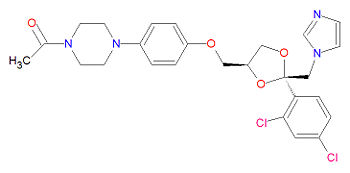Ketoconazole: Difference between revisions
imported>David E. Volk No edit summary |
imported>David E. Volk (ref) |
||
| Line 5: | Line 5: | ||
== Mechanism of action == | == Mechanism of action == | ||
Azole-based antifungal agents, such as ketoconazole, work by inhibiting the enzyme cytochrome P450 14-<math>\alpha</math>-demethylase (P45014DM), which is part of the sterol biosynthesis pathway that converts [[lanosterol]] to [[ergosterol]] | Azole-based antifungal agents, such as ketoconazole, work by inhibiting the enzyme cytochrome P450 14-<math>\alpha</math>-demethylase (P45014DM), which is part of the sterol biosynthesis pathway that converts [[lanosterol]] to [[ergosterol]]<ref name=Patt>{{cite journal | author = Patt, S.L. & Schoolery, J.N. | title = Attached Proton Test for Carbon-13 NMR | journal = Drugs | title = Systemically administered antifungal agents. A review of the their clinical pharmacology and therapeutic applications | authors = Lyman, C. A. and Walsh, T. J. | volume = 44 | pages = 9-35 | year = 1992 }}</ref>. Because ketoconazole has less affinity towards fungal cell membranes than the newer triazole antifungal agents like fluconazole and itraconazole, it is more likely to bind with mammalian cell membranes and induce toxicity. | ||
. Because ketoconazole has less affinity towards fungal cell membranes than the newer triazole antifungal agents like fluconazole and itraconazole, it is more likely to bind with mammalian cell membranes and induce toxicity. | |||
== Side effects == | == Side effects == | ||
Revision as of 13:04, 3 March 2008
Ketoconazole is one of the azole-based antifungal drugs used to treat fungal infections. Its use has greatly diminished because of the introduction of better treatment alternatives, including the triazoles fluconazole and itraconazole.
Mechanism of action
Azole-based antifungal agents, such as ketoconazole, work by inhibiting the enzyme cytochrome P450 14--demethylase (P45014DM), which is part of the sterol biosynthesis pathway that converts lanosterol to ergosterol[1]. Because ketoconazole has less affinity towards fungal cell membranes than the newer triazole antifungal agents like fluconazole and itraconazole, it is more likely to bind with mammalian cell membranes and induce toxicity.
Side effects
Becuase ketoconazole disrupts part of the sterol biosynthesis pathway, it may decrease levels of the steroids testosterone and cortisone causing gynecomastia and oligospermia in males and irregular menstration in women. It may also cause anorexia, nausea and vomiting, increased levels of transaminase and liver toxicity.
External links
- Doctorfungus [1]
- ↑ Patt, S.L. & Schoolery, J.N. (1992). "Systemically administered antifungal agents. A review of the their clinical pharmacology and therapeutic applications". Drugs 44: 9-35.

